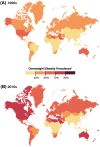Individuals with obesity and COVID-19: A global perspective on the epidemiology and biological relationships
- PMID: 32845580
- PMCID: PMC7461480
- DOI: 10.1111/obr.13128
Individuals with obesity and COVID-19: A global perspective on the epidemiology and biological relationships
Erratum in
-
Erratum.Obes Rev. 2021 Oct;22(10):e13305. doi: 10.1111/obr.13305. Epub 2021 Aug 3. Obes Rev. 2021. PMID: 34346144 Free PMC article. No abstract available.
Abstract
The linkage of individuals with obesity and COVID-19 is controversial and lacks systematic reviews. After a systematic search of the Chinese and English language literature on COVID-19, 75 studies were used to conduct a series of meta-analyses on the relationship of individuals with obesity-COVID-19 over the full spectrum from risk to mortality. A systematic review of the mechanistic pathways for COVID-19 and individuals with obesity is presented. Pooled analysis show individuals with obesity were more at risk for COVID-19 positive, >46.0% higher (OR = 1.46; 95% CI, 1.30-1.65; p < 0.0001); for hospitalization, 113% higher (OR = 2.13; 95% CI, 1.74-2.60; p < 0.0001); for ICU admission, 74% higher (OR = 1.74; 95% CI, 1.46-2.08); and for mortality, 48% increase in deaths (OR = 1.48; 95% CI, 1.22-1.80; p < 0.001). Mechanistic pathways for individuals with obesity are presented in depth for factors linked with COVID-19 risk, severity and their potential for diminished therapeutic and prophylactic treatments among these individuals. Individuals with obesity are linked with large significant increases in morbidity and mortality from COVID-19. There are many mechanisms that jointly explain this impact. A major concern is that vaccines will be less effective for the individuals with obesity.
Keywords: COVID-19; individuals with obesity; meta-analysis; vaccination.
© 2020 The Authors. Obesity Reviews published by John Wiley & Sons Ltd on behalf of World Obesity Federation.
Conflict of interest statement
The authors declare that they have no competing interests.
Figures








Comment in
-
COVID-19 severity and obesity: are MAIT cells a factor?Lancet Respir Med. 2021 May;9(5):445-447. doi: 10.1016/S2213-2600(21)00140-5. Epub 2021 Apr 9. Lancet Respir Med. 2021. PMID: 33844997 Free PMC article. No abstract available.
-
Reply to the John Speakman critique of "Impact of obesity on COVID-19 related mortality: A comment on estimates in Popkin et al (2020)" published in Obesity Reviews.Obes Rev. 2021 Aug;22(8):e13259. doi: 10.1111/obr.13259. Epub 2021 Apr 14. Obes Rev. 2021. PMID: 33855774 No abstract available.
-
Impact of obesity on COVID-19-related mortality: A comment on estimates in Popkin et al 2020.Obes Rev. 2021 Aug;22(8):e13250. doi: 10.1111/obr.13250. Epub 2021 May 5. Obes Rev. 2021. PMID: 33949104 Free PMC article. No abstract available.
References
-
- World Cancer Research Fund/American Institute for Cancer Research . Diet, nutrition, physical activity and cancer: a global perspective (A summary of the third expert report). London: WCRF 2018.
Publication types
MeSH terms
Grants and funding
LinkOut - more resources
Full Text Sources
Other Literature Sources
Medical

